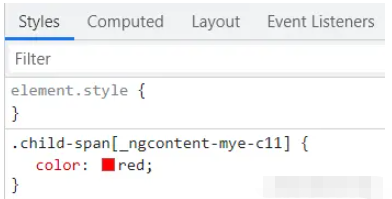жӮЁеҘҪпјҢзҷ»еҪ•еҗҺжүҚиғҪдёӢи®ўеҚ•е“ҰпјҒ
жӮЁеҘҪпјҢзҷ»еҪ•еҗҺжүҚиғҪдёӢи®ўеҚ•е“ҰпјҒ
д»ҠеӨ©е°Ҹзј–з»ҷеӨ§е®¶еҲҶдә«дёҖдёӢangularеҰӮдҪ•иҝӣиЎҢж ·ејҸйҡ”зҰ»зҡ„зӣёе…ізҹҘиҜҶзӮ№пјҢеҶ…е®№иҜҰз»ҶпјҢйҖ»иҫ‘жё…жҷ°пјҢзӣёдҝЎеӨ§йғЁеҲҶдәәйғҪиҝҳеӨӘдәҶи§Јиҝҷж–№йқўзҡ„зҹҘиҜҶпјҢжүҖд»ҘеҲҶдә«иҝҷзҜҮж–Үз« з»ҷеӨ§е®¶еҸӮиҖғдёҖдёӢпјҢеёҢжңӣеӨ§е®¶йҳ…иҜ»е®ҢиҝҷзҜҮж–Үз« еҗҺжңүжүҖ收иҺ·пјҢдёӢйқўжҲ‘们дёҖиө·жқҘдәҶи§ЈдёҖдёӢеҗ§гҖӮ
angular д»Ҙ组件дёәеҹәжң¬еҚ•дҪҚгҖӮжҲ‘们编еҶҷдёҖдёӘдёҖдёӘзҡ„组件пјҢеҶҚе°Ҷиҝҷдәӣ组件组еҗҲдёәдёҖйў—з»„д»¶ж ‘гҖӮдҪҶжҳҜеңЁејҖеҸ‘зҡ„иҝҮзЁӢдёӯпјҢз»ҸеёёйңҖиҰҒеңЁзҲ¶з»„件дёӯиҰҶзӣ–еӯҗ组件зҡ„ж ·ејҸгҖӮжҜ”еҰӮзҺ°еңЁжҲ‘们жңүдёҖдёӘparent 组件е’Ңchild 组件пјҢchild 组件йҮҢйқўжңүдёҖдёӘspanпјҢspan зҡ„еӯ—дҪ“дёәзәўиүІгҖӮ
еҰӮдёӢжүҖзӨәпјҡ
//child.componet.html
<span class="child-span">child span</span>
//child.component.scss
.child-span {
color: red;
}
еҰӮжһңзҺ°еңЁпјҢparent 组件жғіиҰҒchild 组件дёӯspan зҡ„еҶ…е®№еҸҳжҲҗз»ҝиүІгҖӮеҸҜд»ҘдҪҝз”ЁеҰӮдёӢзҡ„ж–№ејҸ
//parent.component.scss
app-child {
::ng-deep {
.child-span {
color: green;
}
}
}
еңЁparent 组件дёӯпјҢдҪҝз”Ёangular жҸҗдҫӣзҡ„::ng-deep е…ій”®еӯ—иҝӣиЎҢж ·ејҸзҡ„иҰҶзӣ–гҖӮ
зҺ°еңЁжҲ‘们дҝ®ж”№дёҖдёӢchild 组件зҡ„еҶ…е®№пјҢеңЁspan еӨ–йқўеҠ дёҠдёҖеұӮdivпјҢжҜ•з«ҹзҺ°е®һдёӯзҡ„组件иӮҜе®ҡдёҚдјҡеҸӘжңүдёҖеұӮиҝҷд№Ҳз®ҖеҚ•гҖӮ
//child.componet.html
<div class="child-div">
<span class="child-span">child span</span>
</div>
//child.component.scss
.child-div {
.child-span {
color: red;
}
}
иҝҷж—¶еҖҷпјҢжҲ‘们дјҡеҸ‘зҺ°child 组件дёӯspan зҡ„еҶ…е®№еҸҲеҸҳеӣһдәҶзәўиүІпјҢд№ӢеүҚparent 组件еҜ№е…¶зҡ„иҰҶзӣ–并没жңүз”ҹж•ҲгҖӮ
::ng-deep дёәд»Җд№ҲдјҡеӨұж•Ҳе‘ўпјҹжҲ–иҖ…иҜҙпјҢ::ng-deep дјҡеңЁд»Җд№Ҳж—¶еҖҷжңүж•Ҳпјҹд»Җд№Ҳж—¶еҖҷеӨұж•ҲпјҹжӣҙиҝӣдёҖжӯҘиҜҙпјҢangular дёӯ组件е’Ң组件д№Ӣй—ҙзҡ„ж ·ејҸйҡ”зҰ»жҳҜжҖҺд№ҲеҒҡеҲ°зҡ„е‘ўпјҹ
css дёӯжҸҗдҫӣдәҶе…ғзҙ йҖүжӢ©еҷЁпјҢid йҖүжӢ©еҷЁпјҢclass йҖүжӢ©еҷЁд»ҘеҸҠеұһжҖ§йҖүжӢ©еҷЁгҖӮ
еҜ№дәҺangular зҡ„ж ·ејҸйҡ”зҰ»зҡ„й—®йўҳпјҢжҜ”иҫғйҮҚиҰҒзҡ„е°ұжҳҜеұһжҖ§йҖүжӢ©еҷЁгҖӮ еңЁеұһжҖ§йҖүжӢ©еҷЁдёӯпјҢйҖҡиҝҮз»ҷе…ғзҙ ж·»еҠ д»»ж„ҸдёҖдёӘеұһжҖ§пјҢеҸҜд»ҘеҮҶзЎ®ең°йҖүдёӯиҝҷдёӘе…ғзҙ гҖӮ жҜ”еҰӮиҜҙпјҢ
a[target] {
background-color:yellow;
}
йҖҡиҝҮдёҠйқўзҡ„йҖүжӢ©еҷЁпјҢжҲ‘们еҸҜд»ҘйҖүдёӯжүҖжңүеёҰжңүtargetеұһжҖ§зҡ„aе…ғзҙ гҖӮ
еҸҰеӨ–дёҖдёӘжҳҜеҗҺд»ЈйҖүжӢ©еҷЁгҖӮ
еңЁcss дёӯпјҢеҗҺд»ЈйҖүжӢ©еҷЁдјҡйҖүжӢ©жҢҮе®ҡе…ғзҙ зҡ„жүҖжңүеҗҺд»Је…ғзҙ гҖӮ жҜ”еҰӮпјҢ
[attr] span {
color: green;
}
иҝҷдёӘйҖүжӢ©еҷЁдјҡйҰ–е…ҲйҖүдёӯеёҰжңүattr еұһжҖ§зҡ„е…ғзҙ пјҢ然еҗҺйҖүдёӯиҝҷдёӘе…ғзҙ зҡ„жүҖжңүеҗҺд»Јspan е…ғзҙ гҖӮ
жңүдәҶcss еұһжҖ§йҖүжӢ©еҷЁе’ҢеҗҺд»ЈйҖүжӢ©еҷЁпјҢе°ұжңүдәҶйңҖиҰҒе®ҢжҲҗз»„д»¶ж ·ејҸйҡ”зҰ»зҡ„жүҖжңүе·Ҙе…·гҖӮangular дёӯ组件зҡ„ж ·ејҸйҡ”зҰ»дёҺ::ng-deep е®Ңе…ЁеҹәдәҺиҝҷдёӨдёӘеҶ…е®№гҖӮ
жҲ‘们зҺ°еңЁеӣһеҲ°д№ӢеүҚзҡ„angular组件 child 组件зҡ„еҶ…е®№дёә
//child.componet.html
<span class="child-span">child span</span>
//child.component.scss
.child-span {
color: red;
}
parent 组件зҡ„еҶ…е®№дёә
//parent.component.html
<app-child></app-child>
дёҠйқўдёӨдёӘ组件з»ҸиҝҮangular еӨ„зҗҶд»ҘеҗҺпјҢз”ҹжҲҗзҡ„html еҶ…е®№еҰӮдёӢ

еҸҜд»ҘзңӢеҲ°пјҢparent 组件дёҠйқўеӨҡдәҶ_ngcontent-mye-c13 е’Ң_nghost-mye-c12 дёӨдёӘеұһжҖ§пјҢиҖҢchild 组件дёҠйқўеӨҡдәҶ_ngcontent-mye-c12 е’Ң_nghost-mye-c11 дёӨдёӘеұһжҖ§пјҢchild 组件дёӢзҡ„span ж ҮзӯҫпјҢеўһеҠ дәҶ_nghost-mye-c11 еұһжҖ§гҖӮ
еҜ№дәҺscss ж–Ү件пјҢз»ҸиҝҮangular зҡ„еӨ„зҗҶд»ҘеҗҺпјҢеңЁchild 组件дёӯзҡ„.child-span зұ»пјҢеҸҳжҲҗдәҶ.child-span[_nghost-mye-c11]гҖӮ

йҖҡиҝҮиҝҷдәӣеҶ…е®№жҲ‘们е°ұеҸҜд»ҘзңӢеҮәжқҘangular зҡ„ж ·ејҸйҡ”зҰ»е°ұжҳҜеҲ©з”ЁеұһжҖ§йҖүжӢ©еҷЁе®ҢжҲҗзҡ„гҖӮ
_nghost-mye-c11 иҝҷдёӘеұһжҖ§еҸӘдјҡеҮәзҺ°еңЁchild 组件дёӯгҖӮеңЁchild.component.scss дёӯзҡ„.child-spanзұ»еҸҳжҲҗдәҶ.child-span[_nghost-mye-c11]пјҢж №жҚ®д№ӢеүҚжҸҗеҲ°зҡ„еұһжҖ§йҖүжӢ©еҷЁзҡ„жңәеҲ¶пјҢ.child-span еҸӘдјҡеҜ№child 组件зҡ„еҶ…е®№з”ҹж•ҲгҖӮ
еҰӮжһңеңЁparent 组件еҶ…йғЁд№ҹеҶҷдёҖдёӘ.child-spanзұ»йҖүжӢ©еҷЁпјҢйӮЈд№Ҳз”ҹжҲҗзҡ„зұ»йҖүжӢ©еҷЁе°ұдјҡжҳҜ.child-span[_nghost-mye-c12]гҖӮиҖҢ_nghost-mye-c12 иҝҷдёӘеұһжҖ§жҳҜеұһдәҺparent 组件зҡ„пјҢдәҺжҳҜиҝҷдёӘ.child-span зұ»еҸӘдјҡеҜ№parent 组件зҡ„еҶ…е®№з”ҹж•ҲгҖӮ并дёҚдјҡеҪұе“ҚеҲ°child 组件пјҢж ·ејҸзҡ„йҡ”зҰ»д№ҹе°ұе®ҢжҲҗдәҶгҖӮ
йӮЈдёәд»Җд№ҲйҖҡиҝҮ::ng-deep еҸҜд»ҘеңЁparent 组件йҮҢйқўпјҢиҰҶзӣ–child 组件дёӯзҡ„еҶ…е®№е‘ўпјҹ
//parent.component.scss
app-child {
::ng-deep {
.child-span {
color: green;
}
}
}
дёҠйқўзҡ„еҶ…е®№йҖҡиҝҮangular еӨ„зҗҶд»ҘеҗҺпјҢз”ҹжҲҗзҡ„еҶ…е®№дёәapp-child[_nghost-mye-c12] .child_spanгҖӮдҪҚдәҺ::ng-deep еҗҺйқўзҡ„зұ»пјҢеҺ»жҺүдәҶиҮӘеҠЁж·»еҠ зҡ„еұһжҖ§пјҢиҝҷж—¶еҖҷж №жҚ®css зҡ„еҗҺд»ЈйҖүжӢ©еҷЁжңәеҲ¶гҖӮapp-child[_nghost-mye-c12] .child_spanдјҡйҖүдёӯchild 组件дёӢйқўзҡ„жүҖжңүеёҰжңү.child_span зұ»зҡ„ж ҮзӯҫпјҢиҖҢдё”ж №жҚ®дјҳе…Ҳзә§и®Ўз®—пјҢapp-child[_nghost-mye-c12] .child_span й«ҳдәҺchild 组件з”ҹжҲҗзҡ„.child_span[_nghost-mye-c11] пјҢдәҺжҳҜchild 组件дёӯзҡ„ж ·ејҸе°ұиў«иҰҶзӣ–жҺүдәҶгҖӮ
йӮЈдёәд»Җд№Ҳжңүж—¶еҖҷ::ng-deepдёҚиғҪеӨҹиҰҶзӣ–жҺүе‘ўпјҹжҜ”еҰӮпјҢеҪ“child 组件代з ҒеҰӮдёӢзҡ„ж—¶еҖҷ
//child.componet.html
<div class="child-div">
<span class="child-span">child span</span>
</div>
//child.component.scss
.child-div {
.child-span {
color: red;
}
}
иҝҷж—¶еҖҷеҚідҪҝжҲ‘们еҸ‘зҺ°child 组件дёӯspan зҡ„йўңиүІдҫқж—§жҳҜзәўиүІгҖӮ
е®һйҷ…дёҠеҺҹеӣ д№ҹдёҚеӨҚжқӮпјҢжЈҖжҹҘangular з”ҹжҲҗзҡ„ж ·ејҸж–Ү件еҗҺпјҢжҲ‘们еҸҜд»ҘеҸ‘зҺ°пјҢд№ӢжүҖд»ҘжІЎжңүжҠҠиҰҶзӣ–жҺүпјҢзәҜзІ№жҳҜеӣ дёәcss йҖүжӢ©еҷЁдјҳе…Ҳзә§зҡ„й—®йўҳгҖӮchild 组件з”ҹжҲҗзҡ„ж ·ејҸ.child-div[_nghost-mye-c11] .child-span[_nghost-mye-c11] дјҳе…Ҳзә§й«ҳдәҺparent 组件з”ҹжҲҗзҡ„ж ·ејҸapp-child[_nghost-mye-c12] .childгҖӮдәҺжҳҜпјҢжҲ‘们зңӢеҲ°зҡ„ж•Ҳжһңе°ұжҳҜparent 组件дёӯзҡ„::ng-deep жІЎжңүз”ҹж•ҲпјҢдёҖз§ҚжҜ”иҫғеҝ«жҚ·зҡ„еҒҡжі•жҳҜзӣҙжҺҘеңЁparent 组件зҡ„ж ·ејҸеҗҺйқўеҠ дёҠ!importantгҖӮдҪҶжҳҜз”ұдәҺ!important жқғйҮҚеӨӘй«ҳзҡ„еҺҹеӣ пјҢ并дёҚжҳҜеҫҲжҺЁиҚҗгҖӮжӯӘдёӘжҘјпјҢеңЁеҸ‘зҺ°angular ::ng-deep еӨұж•Ҳзҡ„еҺҹеӣ д№ӢеүҚпјҢеҫҲйҒ—жҶҫпјҢйЎ№зӣ®д№ӢеүҚеҫҲеӨҡең°ж–№зҡ„йғҪжңүиҝҷз§Қз”Ёжі•гҖӮ
еҸҰдёҖдёӘж–№жі•е°ұжҳҜпјҢ既然жҳҜеӣ дёәдјҳе…Ҳзә§дёҚеӨҹпјҢйӮЈд№ҲжҸҗй«ҳparent 组件з”ҹжҲҗзҡ„ж ·ејҸзҡ„дјҳе…Ҳзә§е°ұеҸҜд»ҘдәҶгҖӮ дҝ®ж”№parent 组件зҡ„д»Јз Ғдёә
:host {
app-child {
::ng-deep {
.child-div {
.child-span {
color: green;
}
}
}
}
}
иҝҷж—¶еҖҷпјҢparent 组件з”ҹжҲҗзҡ„ж ·ејҸ[_nghost-mye-c12] app-child[_nghost-mye-c12] .child-div .child-span дјҳе…Ҳзә§й«ҳдәҺchild 组件з”ҹжҲҗзҡ„ж ·ејҸ.child-div[_nghost-mye-c11] .child-span[_nghost-mye-c11] пјҢchild 组件дёӯspan зҡ„йўңиүІд№ҹе°ұеҸҳз»ҝдәҶгҖӮ
иҝҷйҮҢжҲ‘们дҪҝз”ЁдәҶ:host е…ій”®еӯ—пјҢжҺҘдёӢжқҘпјҢжҲ‘们з®ҖеҚ•зңӢзңӢе®ғзҡ„дҪңз”ЁгҖӮ
дёҠдёӘе°Ҹз»“дёӯпјҢparent 组件з”ҹжҲҗзҡ„ж ·ејҸжҳҜ[_nghost-mye-c12] app-child[_nghost-mye-c12] .child-div .child-spanпјҢеҰӮжһңеҺ»жҺү:hostпјҢе°ұдјҡеҸ‘зҺ°пјҢз”ҹжҲҗзҡ„ж ·ејҸеҸҳжҲҗдәҶapp-child[_nghost-mye-c12] .child-div .child-spanгҖӮжүҖд»Ҙ:host е…ій”®еӯ—еҸӘжҳҜз»ҷз”ҹжҲҗзҡ„ж ·ејҸпјҢеҠ дёҠдәҶparent 组件еұһжҖ§еӯ—ж®өиҖҢе·ІгҖӮ
йӮЈиҝҷдёӘ:hostжңүд»Җд№Ҳз”Ёе‘ўпјҹ
еёёи§Ғзҡ„дҪңз”ЁжңүдёӨдёӘгҖӮ
дёҖдёӘе°ұжҳҜйҖүжӢ©еҪ“еүҚзҡ„组件ж ҮзӯҫпјҢеңЁangular дёӯпјҢжҲ‘们иҮӘе®ҡд№үзҡ„组件пјҢжҜ”еҰӮиҝҷйҮҢзҡ„parent 组件app-parent е’Ңchild 组件app-child жңҖеҗҺйғҪжҳҜдјҡжёІжҹ“еҲ°з”ҹжҲҗзҡ„html ж–ҮжЎЈдёҠзҡ„гҖӮеҰӮжһңйңҖиҰҒйҖүдёӯиҝҷдәӣж ҮзӯҫпјҢе°ұеҸҜд»ҘдҪҝз”Ё:host е…ій”®еӯ—гҖӮ
еҸҰдёҖдёӘдҪңз”ЁиҝҳжҳҜйҡ”зҰ»ж ·ејҸпјҢе°Ҷclass зұ»еҶҷеңЁ:host еҶ…йғЁпјҢиҝҷдёӘзұ»ж— и®әеҰӮдҪ•д№ҹжҳҜдёҚеҸҜиғҪжі„жјҸеҲ°е…ЁеұҖеҺ»зҡ„гҖӮе®һйҷ…дёҠпјҢйҖҡиҝҮеүҚйқўзҡ„еҶ…е®№еҲҶжһҗеҸҜд»ҘеҸ‘зҺ°пјҢдёҚеҶҷеңЁ:host йҮҢйқўпјҢд№ҹдёҚдјҡжі„жјҸеҲ°е…ЁеұҖгҖӮдҪҶжҳҜеҰӮжһңеҮәзҺ°дәҶд»ҘдёӢзҡ„жғ…еҶө
//some.component.scss
::ng-deep {
.random-class {
xxxx
}
}
иҝҷдёӘзұ»з»ҸиҝҮangular еӨ„зҗҶд»ҘеҗҺпјҢжңҖеҗҺдјҡеҸҳдёә
.random-class {
xxxx
}
random-class е°ҶдјҡеҜ№е…ЁеұҖйҖ жҲҗеҪұе“ҚгҖӮ
дҪҶжҳҜеҰӮжһңжҠҠе®ғеҢ…иЈ№еңЁ:host еҶ…йғЁпјҢе“ӘжҖ•дҪҝз”ЁдәҶ::ng-deep е…ій”®еӯ—пјҢжңҖеӨҡд№ҹеҸӘдјҡеҪұе“ҚеҲ°иҝҷдёӘ组件зҡ„еҗҺд»Је…ғзҙ гҖӮ
жүҖд»ҘеңЁangular е®ҳж–№ж–ҮжЎЈдёӯжңүдёӢйқўзҡ„дёҖж®өиҜқгҖӮ
Applying the
::ng-deeppseudo-class to any CSS rule completely disables view-encapsulation for that rule. Any style with::ng-deepapplied becomes a global style. In order to scope the specified style to the current component and all its descendants, be sure to include the:hostselector before::ng-deep. If the::ng-deepcombinator is used without the:hostpseudo-class selector, the style can bleed into other components.
д»ҘдёҠе°ұжҳҜвҖңangularеҰӮдҪ•иҝӣиЎҢж ·ејҸйҡ”зҰ»вҖқиҝҷзҜҮж–Үз« зҡ„жүҖжңүеҶ…е®№пјҢж„ҹи°ўеҗ„дҪҚзҡ„йҳ…иҜ»пјҒзӣёдҝЎеӨ§е®¶йҳ…иҜ»е®ҢиҝҷзҜҮж–Үз« йғҪжңүеҫҲеӨ§зҡ„收иҺ·пјҢе°Ҹзј–жҜҸеӨ©йғҪдјҡдёәеӨ§е®¶жӣҙж–°дёҚеҗҢзҡ„зҹҘиҜҶпјҢеҰӮжһңиҝҳжғіеӯҰд№ жӣҙеӨҡзҡ„зҹҘиҜҶпјҢиҜ·е…іжіЁдәҝйҖҹдә‘иЎҢдёҡиө„и®Ҝйў‘йҒ“гҖӮ
е…ҚиҙЈеЈ°жҳҺпјҡжң¬з«ҷеҸ‘еёғзҡ„еҶ…е®№пјҲеӣҫзүҮгҖҒи§Ҷйў‘е’Ңж–Үеӯ—пјүд»ҘеҺҹеҲӣгҖҒиҪ¬иҪҪе’ҢеҲҶдә«дёәдё»пјҢж–Үз« и§ӮзӮ№дёҚд»ЈиЎЁжң¬зҪ‘з«ҷз«ӢеңәпјҢеҰӮжһңж¶үеҸҠдҫөжқғиҜ·иҒ”зі»з«ҷй•ҝйӮ®з®ұпјҡis@yisu.comиҝӣиЎҢдёҫжҠҘпјҢ并жҸҗдҫӣзӣёе…іиҜҒжҚ®пјҢдёҖз»ҸжҹҘе®һпјҢе°Ҷз«ӢеҲ»еҲ йҷӨж¶үе«ҢдҫөжқғеҶ…е®№гҖӮ